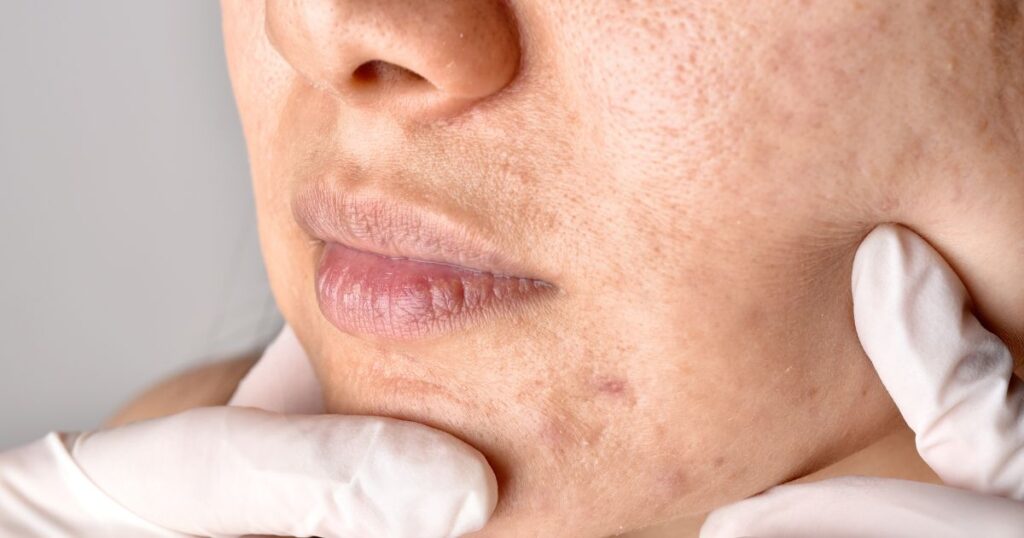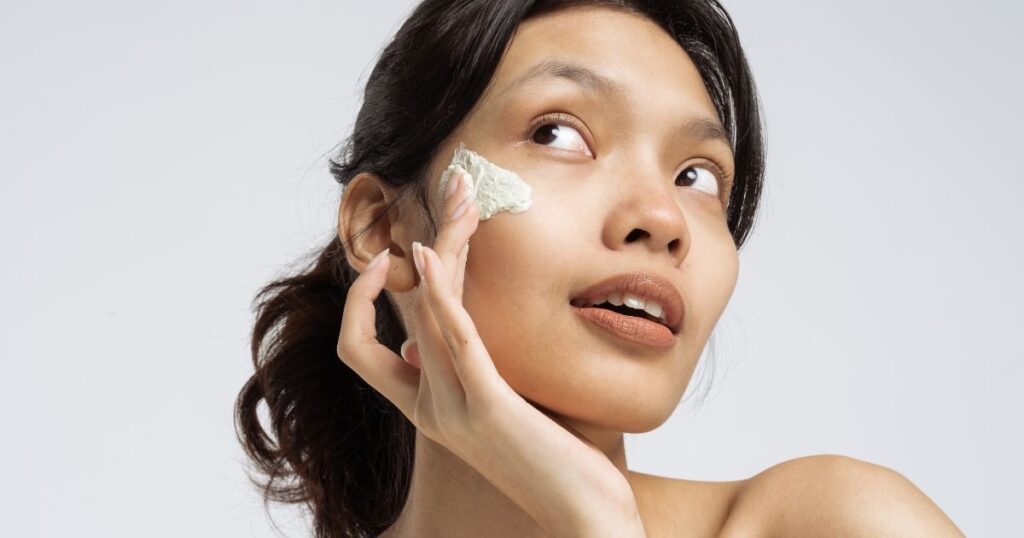Imagine discovering a skincare secret that effortlessly tackles your biggest skin concerns. That secret? Niacinamide. This Vitamin B3 derivative is transforming skincare routines worldwide, promising to:
- Smooth wrinkles and fine lines
- Combat acne
- Fade hyperpigmentation and uneven skin tone
So, what’s behind niacinamide’s sudden rise to fame in the beauty industry? As we peel back the layers, we’ll reveal:
- The Science: How niacinamide works its magic on your skin
- The Benefits: From antioxidant properties to strengthening the skin’s barrier
- Practical Tips: Seamlessly integrating topical niacinamide into your skincare routine
Niacinamide stands out for its gentle yet effective approach, making it an indispensable ally in achieving a radiant complexion.
Table of Contents - Click to Go
The Science Behind Niacinamide
Niacinamide, a standout in the world of skincare, is essentially a form of Vitamin B3. Unlike its more complex counterparts in the skincare aisle, niacinamide boasts a surprisingly straightforward approach to enhancing skin health. Here’s a dive into its scientific backbone:
- Vitamin B3 Variants: Niacinamide, alongside nicotinic acid, represents the two main forms of Vitamin B3. Each plays a pivotal role in our body’s health, but niacinamide shines in topical skincare applications.
- Cellular Mechanism: At the cellular level, niacinamide works its magic by aiding in the repair of DNA, enhancing the function of the epidermal barrier, and accelerating cell turnover. This multifaceted approach results in visibly healthier skin.
- Energy Production: It plays a crucial role in the conversion of food into energy, feeding skin cells to promote vitality and resilience.
- Antioxidant Properties: Niacinamide also acts as a potent antioxidant, neutralizing harmful free radicals that can accelerate skin aging.
The science behind niacinamide highlights its role as a gentle yet powerful ingredient, capable of addressing a broad spectrum of skin care concerns without the harshness often associated with other active ingredients. Its versatility and efficacy at the cellular level underscore why it’s become a staple in skincare formulations.
Key Benefits of Niacinamide for Skin Health

Niacinamide’s acclaim in skincare isn’t unfounded; its benefits span across various skin-related concerns, making it a revered ingredient for anyone keen on a radiant, healthy complexion. Here’s a closer look at its key benefits:
1. Enhances Skin Barrier Function
- Strengthening Skin’s Moisture Barrier: Boosts the skin’s ability to retain moisture by increasing ceramide production. A robust barrier retains moisture better, keeping the skin hydrated and plump.
- Protective Shield: Strengthens the skin’s natural defense against environmental stressors, preventing damage.
2. Reduces Inflammation
- Calms Redness: Offers relief for skin conditions like acne and eczema by soothing inflammation.
- Healing Support: Accelerates healing processes, reducing the visibility of post-acne marks and other blemishes.
3. Balances Oil Production
- Regulates Sebum: Ideal for oily skin types, as it helps normalize sebum production which can visibly tighten pores, leading to a balanced, matte finish.
- Pore Appearance: With less oil, pores appear smaller and your skin’s texture becomes more refined.
4. Treats Hyperpigmentation
- Even Skin Tone: Works to fade dark spots, hyperpigmentation, and rosacea prone skin by inhibiting melanosome transfer from melanocytes to keratinocytes.
- Brighter Complexion: Regular use results in brightening skin tone.
5. Minimizes Signs of Aging
- Fine Lines and Wrinkles: Helps retain skin smoothing moisture, which promotes skin elasticity, reducing the appearance of fine lines and wrinkles.
- Skin Resilience: Enhances skin’s firmness, contributing to a more youthful appearance over time.
6. Treats Acne
- Prevents Breakouts: By controlling sebum production and offering anti-inflammatory benefits, niacinamide can reduce the frequency and severity of acne breakouts.
- Post-Acne Healing: Helps in fading acne scars and marks, improving the overall skin texture.
Incorporating niacinamide into your skincare routine unlocks these transformative benefits, catering to a wide array of skin problems without irritation. Its multifunctional nature not only simplifies skincare routines but also enhances the overall health and appearance of the skin.
How to Incorporate Niacinamide into Your Skincare Routine

Integrating niacinamide into your skincare regimen is straightforward, thanks to its compatibility with various skin types and other skincare ingredients. Here’s how you can seamlessly add this powerhouse ingredient to your routine for optimal benefits:
1. Choose the Right Product
- Variety of Products: Niacinamide is available in serums, creams, and toners. Choose a product based on your skin’s needs and your routine’s complexity.
- Concentration Matters: Look for products with niacinamide concentrations between 2% to 10%, which are effective yet gentle on the skin.
2. Apply it Correctly
- Start Slow: If you’re new to niacinamide, start by applying it every other day to gauge your skin’s response before moving to daily use.
- Layering: Apply niacinamide after cleansing and toning the skin’s surface, but before heavier creams or oils. It can be used both morning and night.
- Sunscreen: Pairing niacinamide with sunscreen in the morning amplifies its benefits, as it can help repair and protect skin from UV damage.
3. Choose the Right Concentration
- Low to Moderate Concentration: Ideal for beginners or those with a sensitive skin type. Even at lower concentrations, niacinamide can offer significant benefits.
- High Concentration: More potent products are available for those targeting specific concerns like deep wrinkles or severe hyperpigmentation, but always patch test first.
4. Make Sure It’s Compatible With Other Ingredients
- Complementary Ingredients: Niacinamide works well with most skincare ingredients, including hyaluronic acid, retinol, and vitamin C, enhancing their benefits.
- Avoiding Irritation: While niacinamide is generally well-tolerated, pairing it with too many active ingredients at once can overwhelm the skin. Monitor your skin’s response and adjust as needed.
Incorporating niacinamide into your skincare routine doesn’t require a complete overhaul. By selecting the right product and following these application tips, you can enjoy the myriad benefits of niacinamide without complicating your regimen.
Niacinamide in Clinical Studies: What Research Says
The effectiveness of niacinamide in skincare isn’t just anecdotal; it’s backed by robust scientific research. Clinical studies have rigorously tested niacinamide’s impact on skin health, offering compelling evidence of its benefits. Here’s what the research says:
1. Improves Skin Barrier Function
Studies have shown that niacinamide significantly increases the production of ceramides, essential lipids in the skin’s barrier, leading to improved moisture retention and barrier function.
2. Reduces Inflammation and Redness
Clinical trials demonstrate niacinamide’s ability to reduce inflammation and redness in the skin, making it an effective solution to treat acne and other inflammatory skin conditions.
3. Balances Oil Production
Research indicates that niacinamide can regulate sebum production, contributing to a reduction in the appearance of pores and helping to prevent acne breakouts in oily skin types.
4. Effective in Treating Hyperpigmentation
Several studies have confirmed that niacinamide brightens skin and is effective in lightening dark spots and hyperpigmentation by inhibiting the transfer of melanin to the skin’s surface.
5. Anti-Aging Properties
Niacinamide has been found to improve the elasticity of the skin, leading to visibly reduced fine lines and wrinkles, according to multiple clinical studies.
6. Safe for Long-Term Use
Longitudinal studies highlight niacinamide’s safety for long-term use, showing minimal to no adverse effects, making it suitable for continuous application as part of a daily skincare regimen.
Personalizing Your Skincare: Combining Niacinamide with Other Ingredients
Niacinamide’s versatility allows it to be a synergistic partner to many other skincare ingredients, enhancing their benefits and tailoring your skincare routine to your specific needs. Here’s how to smartly combine niacinamide with other key ingredients for a personalized skincare approach:
1. Niacinamide and Hyaluronic Acid
- Hydration Boost: Pairing these two powerhouses can significantly increase your skin’s hydration levels. Niacinamide strengthens the skin barrier, while hyaluronic acid locks in moisture.
- Application: Use a niacinamide serum followed by a hyaluronic acid moisturizer to plump and hydrate the skin effectively.
2. Niacinamide and Vitamin C
- Brightening and Repairing: Once believed to be incompatible, recent research suggests that niacinamide and vitamin C can be combined to enhance skin brightening and repair damage.
- Layering Tip: Apply vitamin C serum in the morning for its antioxidant properties and niacinamide at night to repair skin and regulate oil production.
3. Niacinamide and Retinol
- Anti-Aging Synergy: Combining niacinamide with retinol can help mitigate the irritation commonly associated with retinol use. Niacinamide’s soothing properties calm the skin, while retinol works on fine lines.
- Usage: Apply retinol followed by niacinamide. Alternatively, look for products that contain both ingredients to simplify your routine.
4. Niacinamide and Salicylic Acid
- Acne and Pore Care: If acne is a skin concern for you, combining niacinamide with salicylic acid can be a game-changer for acne prone skin. Salicylic acid exfoliates and unclogs pores, while niacinamide reduces inflammation and controls sebum.
- Routine: Use a salicylic acid cleanser followed by a niacinamide serum for clear, refined skin.
5. Niacinamide and Peptides
- Skin Firmness and Elasticity: Peptides, which stimulate collagen production, pair well with niacinamide to improve skin texture and firmness.
- Combining: Look for serums or moisturizers that incorporate both niacinamide and peptides for a potent anti-aging effect.
Improve Your Skin Tone and Skin Texture With Niacinamide

Niacinamide, with its wide array of skin benefits, stands as a testament to the power of targeted skincare ingredients. From strengthening the skin barrier to reducing inflammation, balancing oil production, and diminishing the signs of aging, niacinamide offers a comprehensive solution to many skin concerns. Its ability to seamlessly integrate into various skincare routines, alongside a multitude of other ingredients, underscores its versatility and efficacy.
FAQ: Niacinamide in Skincare
What exactly is niacinamide and how does it benefit the skin?
Niacinamide is a form of Vitamin B3 that plays a crucial role in reducing inflammation, strengthening the skin barrier, regulating oil production, and improving the skin’s texture and tone. It’s known for its versatility in treating a wide range of skin issues, from acne and rosacea to aging signs and hyperpigmentation.
How often should I use niacinamide in my skincare routine?
Niacinamide can be used daily, morning and night, as it is well-tolerated by most skin types. Starting with once a day application and gradually increasing to twice daily as your skin adapts is advisable.
Is niacinamide suitable for all skin types?
Niacinamide is generally suitable for all skin types, including sensitive skin. Its anti-inflammatory properties make it particularly beneficial for acne-prone and rosacea-affected skin.
How long does it take to see results from using niacinamide?
While some immediate benefits like hydration and reduced redness can be noticed early on, significant improvements in skin texture, oil regulation, and hyperpigmentation typically take 4-8 weeks of consistent use.
Can niacinamide help with acne scars?
Niacinamide can help lighten post-acne marks and scars by improving skin texture and reducing inflammation, contributing to a more even skin tone over time.
Are there any side effects of using niacinamide?
Niacinamide is generally well-tolerated, but some individuals may experience mild irritation, such as redness or itching, when they first start using it. These symptoms typically subside with continued use.
What concentration of niacinamide is most effective?
Products containing 2% to 10% niacinamide are considered effective for most skin issues. Higher concentrations can be used for targeted treatments, but it’s important to introduce them gradually to avoid irritation.

